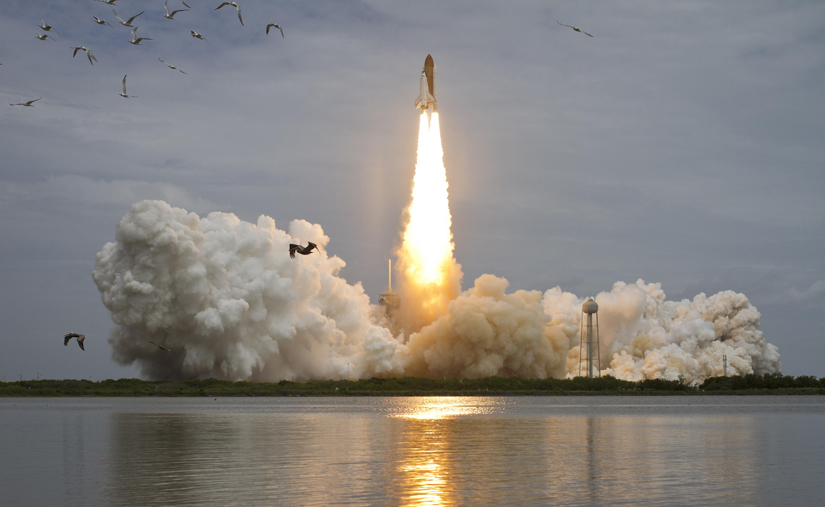According to NASA launch director Michael Leinbach, it is “the final flight of a true American icon.” Whether or not the Atlantis Shuttle Spacecraft has achieved iconic status or not is open to question, but there can be no question that the national news media have treated the launch of STS-135 with an incredible nostalgia that has all but erased the most tragic moments in the thirty year history of the space shuttle program. Mention of the Challenger and the Columbia Space Shuttle disasters is there, of course, but as a footnote to the alleged successes of the program, rather than as a cautionary tale to our continuing flirtation with modernity’s gamble—the wager that the long-term dangers of a technology-intensive society will be avoided by continued progress. And in its place is a romanticized tale–or rather, a romantic-technological optic–that casts our gaze first upon close-up images that underscore the sleek, powerful body of the shuttle itself, making it larger than life. Having visually fetishized the technology, our gaze is then directed from a distance upon the enormity of the Shuttle’s power as it blasts off from the launch pad (see here, here, and here).
The photograph above, taken by NASA and duly distributed by the media, is representative of this second moment in this optic. Shot as a landscape, the spectator is placed directly on a horizontal plane in front of the scene, but of course at a distance that alleviates any of the risk of being too close to the blast. The image itself is almost perfectly symmetrical, and in a manner that underscores the technological rationality of the scene itself: the shuttle and its tightly triangulated effluence divide the frame in half, with birds (nature at risk but not visibly harmed) on one side and closer to the viewer, a tower of some sort (part of the technology of control) on the other side and farther away from the viewer. But note too the reflection of the flash of the discharge in the water that draws a line directly to the spectator in a manner that simultaneously connects and separates the viewer from the blast.
The identification between spectator and event is central to the romantic-technological optic and is evidenced by the very many photographs that feature families and individuals showing up to witness such events, as well as those that display people taking photographs of the event themselves. The sheer number of such images should clue us to the fact that there is something more going on here than simple documentation or reportage. And of course there is, for the space program has always been driven by its status as a public spectacle, its romance animated by its connection to the myth of the American frontier and the individual(istic) pioneer willing to challenge the unknown. And so the photograph below is perhaps the perfect marker of an Americanized, technological-romantic optic as the polished mirror of the glasses invites the illusion of a near perfect fusion of spectator and event as they appear simultaneously to reflect and absorb the image of the shuttle as it disappears into the clouds. The viewer may not be on the shuttle craft himself, but he is nevertheless cast as one with the project.
But there is more, of course, for the optic is tilted to a nostalgic past that reflects only the successes of the shuttle program and represses any memory of its disasters. And in this regard, notice how the photograph above seems almost to substitute for earlier photographs of individuals witnessing with horror the explosion of the Challenger as it took a similar trajectory towards the heavens.
One might understand why NASA would promote a romantic-technological optic as in its own best interests, but we should take care ourselves to avoid being too easily fooled into yielding to the unrelenting desire to beat the odds of modernity’s gamble. Or, at least when we take the bet, as undoubtedly we may need to do from time to time, we should do it with full recognition that the odds always favor the house and that the risks are not easily managed by simple remembrances of a past that never was quite as happy as we want to recall it.
Photo Credit: NASA; Scott Audette/Reuters.


“our continuing flirtation with modernity’s gamble—the wager that the long-term dangers of a technology-intensive society will be avoided by continued progress.”
Well put, thank you. Seems the stakes keep getting higher.
Dr. Lucaites,
This reminds me of your comments concerning images of nuclear tests and mushroom clouds. Space shuttle launches are performances of technological “prowess” in an illusory space race that I have never understood. (Race to what? Race to where?) Tech-focused images of rockets ascending into space distract us from human-centered problems on the ground. I tend to use education, decent housing, and health care as units of currency, and each space shuttle launch reminds me of the exorbitant cost of these missions in our unbalanced economy. I grew up on the Millenium Falcon and the Enterprise–really cool space ship fantasies!–and the dangerous, noisy, clunky, limited-use Space Shuttles are expensive disappointments. The billions of dollars spent on this obsolescent experiment might have gone to improve our crumbling infrastructure, our declining public schools and universities, or our primitive health care system. These national images of “conquering” space serve no tangible purpose on the ground. America’s identity as world leaders of technology is already compromised by the steady decline in our standard of living here on earth.
Dr. Lucaites,
In the landscape image of the rocket launch, the reflection of the fiery blast in the water could easily be mistaken for the reflection of the rising or setting sun in a more peaceful landscape image, implying that we have indeed harnessed the power of the sun with our technology. From here one could extend the analogy to enrich a plethora interpretations about the final launch, as the sun sets on the shuttle space program.